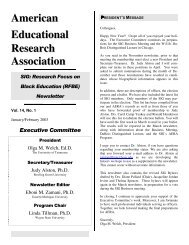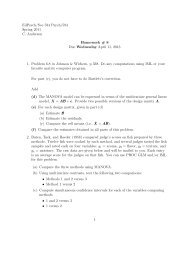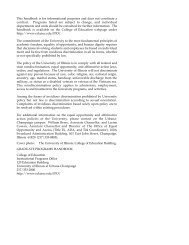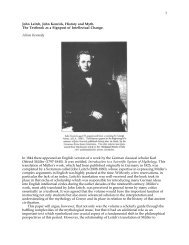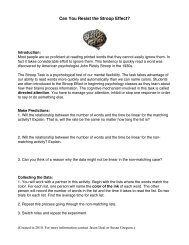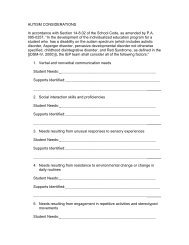The Nature of Critical Thinking: An Outline of Critical ... - Our Faculty
The Nature of Critical Thinking: An Outline of Critical ... - Our Faculty
The Nature of Critical Thinking: An Outline of Critical ... - Our Faculty
Create successful ePaper yourself
Turn your PDF publications into a flip-book with our unique Google optimized e-Paper software.
<strong>The</strong> <strong>Nature</strong> <strong>of</strong> <strong>Critical</strong> <strong>Thinking</strong>: <strong>An</strong> <strong>Outline</strong> <strong>of</strong> <strong>Critical</strong> <strong>Thinking</strong> Dispositionsand Abilities iRobert H. Ennis (rhennis@illinois.edu)Emeritus Pr<strong>of</strong>essor, University <strong>of</strong> IllinoisLast Revised, May, 2011<strong>Critical</strong> thinking is reasonable and reflective thinking focused on deciding what to believeor do. This definition I believe captures the core <strong>of</strong> the way the term is used in the critical thinkingmovement. In deciding what to believe or do, one is helped by the employment <strong>of</strong> a set <strong>of</strong> criticalthinking dispositions and abilities that I shall outline. <strong>The</strong>se can serve as a set <strong>of</strong> comprehensivegoals for a critical thinking curriculum and its assessment. Usefulness in curriculum decisions,teaching, and assessment, not elegance or mutual exclusiveness, is the purpose <strong>of</strong> this outline. Forthe sake <strong>of</strong> brevity, clarification in the form <strong>of</strong> examples, qualifications, and more detail, includingmore criteria, are omitted, but can be found in sources listed below, but most fully in my <strong>Critical</strong><strong>Thinking</strong> (1996a).This outline is the encapsulation <strong>of</strong> many years <strong>of</strong> work in the elaboration <strong>of</strong> the simpledefinition <strong>of</strong> critical thinking given above, and it distinguishes between critical thinking dispositionsand abilities.It is only a critical thinking content outline. It does not specify grade level, curriculum sequence,emphasis, teaching approach, or type <strong>of</strong> subject-matter content involved (standard subject-mattercontent, general knowledge content, streetwise-knowledge content, special knowledge content, etc.).For assessment purposes it can only provide a basis for developing a table <strong>of</strong> specifications and thepreparation <strong>of</strong> assessment rubrics.<strong>Critical</strong> <strong>Thinking</strong> DispositionsIdeal critical thinkers are disposed to1. Care that their beliefs be true ii , and that their decisions be justified; that is, care to "get it right"to the extent possible; including toa. Seek alternative hypotheses, explanations, conclusions, plans, sources, etc.; and be open tothemb. Consider seriously other points <strong>of</strong> view than their ownc. Try to be well informedd. Endorse a position to the extent that, but only to the extent that, it is justified by theinformation that is availablee. Use their critical thinking abilities2. Care to understand and present a position honestly and clearly, theirs as well as others';including toa. Discover and listen to others' view and reasonsb. Be clear about the intended meaning <strong>of</strong> what is said, written, or otherwise communicated,seeking as much precision as the situation requiresc. Determine, and maintain focus on, the conclusion or questiond. Seek and <strong>of</strong>fer reasonse. Take into account the total situationf. Be reflectively aware <strong>of</strong> their own basic beliefs1
3. Care about every person. (This one is an auxiliary, not constitutive, disposition. Although thisconcern for people is not constitutive, critical thinking can be dangerous without it.) Caringcritical thinkersa. Avoid intimidating or confusing others with their critical thinking prowess, taking intoaccount others' feelings and level <strong>of</strong> understandingb. Are concerned about others' welfare<strong>Critical</strong> <strong>Thinking</strong> Abilities<strong>The</strong> following abilities numbered 1 to 3 involve basic clarification; 4 and 5, the bases for a decision;6 to 8, inference; 9 and 10, advanced clarification; and 11 and 12, supposition and integration.Abilities13 to 15 are auxiliary abilities, not constitutive <strong>of</strong> critical thinking, but very helpful.Ideal critical thinkers have the ability to:(Basic Clarification, 1 to 3)1. Focus on a question:a. Identify or formulate a questionb. Identify or formulate criteria forjudging possible answersc. Keep the question and situationin mind2. <strong>An</strong>alyze arguments:a. Identify conclusionsb. Identify reasons or premisesc. Ascribe or identify simpleassumptions (see also ability 10)c. Identify and handle irrelevanced. See the structure <strong>of</strong> an argumente. Summarize3. Ask and answer clarificationand/or challenge questions, suchas:a. Why?b. What is your main point?c. What do you mean by·?d. What would be an example?e. What would not be an example(though close to being one)?f. How does that apply to this case(describe a case, which appearsto be a counterexample)?g. What difference does it make?h. What are the facts?i. Is this what you aresaying:__________________?j. Would you say more about that?(Two Bases for a Decision: 4 and 5)4. Judge the credibility <strong>of</strong> a source.Major criteria (but not necessaryconditions):a. Expertiseb. Lack <strong>of</strong> conflict <strong>of</strong> interestc. Agreement with other sourcesd. Reputatione. Use <strong>of</strong> established proceduresf. Known risk to reputation (thesource’s knowing <strong>of</strong> a risk toreputation, if wrong)g. Ability to give reasonsh. Careful habits5. Observe, and judge observationreports. Major criteria (but notnecessary conditions, except for thefirst):a. Minimal inferring involvedb. Short time interval betweenobservation and reportc. Report by the observer, ratherthan someone else (that is, thereport is not hearsay)d. Provision <strong>of</strong> recordse. Corroborationf. Possibility <strong>of</strong> corroborationg. Good access2
h. Competent employment <strong>of</strong>technology, if technology appliesi. Satisfaction by observer (andreporter, if a different person) <strong>of</strong>the credibility criteria in Ability# 4 above(Note: A third basis is your own establishedconclusions.)(Inference, 6 to 8)6. Deduce, and judge deduction:a. Class logicb. Conditional logicc. Interpretation <strong>of</strong> logicalterminology, including(1) Negation and double negation(2) Necessary and sufficientcondition language(3) Such words as "only", "if andonly if", "or", "some", "unless",and "not both"d. Qualified deductive reasoning(a loosening for practicalpurposes)7. Make material inferences(roughly “induction”):a. To generalizations. Broadconsiderations:(1) Typicality <strong>of</strong> data, includingvalid sampling where appropriate(2) Volume <strong>of</strong> instances(3) Conformity <strong>of</strong> instances togeneralization(4) Having a principled way <strong>of</strong>dealing with outliersb. To explanatory hypotheses(IBE: “inference-to-bestexplanation”):(1) Major types <strong>of</strong> explanatoryconclusions and hypotheses:(a) Specific and general causalclaims(b) Claims about the beliefs andattitudes <strong>of</strong> people(c) Interpretation <strong>of</strong> authors’intended meanings(d) Historical claims that certainthings happened (includingcriminal accusations)(e) Reported definitions(f) Claims that some propositionis an unstated, but used, reason(2) Characteristic investigativeactivities(a) Designing experiments,including planning to controlvariables(b) Seeking evidence andcounterevidence, includingstatistical significance(c) Seeking other possibleexplanations(3) Criteria, the first four beingessential, the fifth being desirable(a) <strong>The</strong> proposed conclusionwould explain or help explain theevidence(b) <strong>The</strong> proposed conclusion isconsistent with all known facts(c) Competitive alternativeexplanations are inconsistentwith facts(d) A competent sincere efforthas been made to find supportingand opposing data, andalternative hypotheses(e) <strong>The</strong> proposed conclusionseems plausible and simple,fitting into the broader picture8. Make and judge value judgmentsImportant factors:a. Background factsb. Consequences <strong>of</strong> accepting orrejecting the judgmentc. Prima facie application <strong>of</strong>acceptable principlesd. Alternativese. Balancing, weighing, deciding(Advanced Clarification, 9 and 10)9. Define terms and judge definitions,using appropriate criteria3
Three basic dimensions are form,function (act), and content. A fourth,more advanced dimension ishandling equivocation.a. Definition form. For criteria for 1through 4 and 6, see Ennis (1996, Ch 12& 13). For #5 see Ennis (1964, 1969c).(1) Synonym(2) Classification(3) Range(4) Equivalent-expression(5) Operational(6) Example and non-exampleb. Definitional functions (acts)(1) Report a meaning (criteria: thefive for an explanatory hypothesis)(2) Stipulate a meaning (criteria:convenience, consistency, avoidance <strong>of</strong>impact equivocation)(3) Express a position on an issue(positional definitions, including"programmatic" and"persuasive" definitions)Criteria: those for a position(Ennis 2001)c. Content <strong>of</strong> the definitiond. Identifying and handlingequivocation (Ennis 1996)10. Attribute unstated assumptions (anability that belongs under both basicclarification (2b) and inference (7b1f)a. Pejorative flavor (dubiousness orfalsity): commonly but not alwaysassociated to some degree with thedifferent types. Criteria: See #8 above.b. Types:(1) Presuppositions (required for aproposition to make sense)(2) Needed assumptions (needed bythe reasoning to be at its strongest, butnot logically necessary (Ennis 1982)),(called “assumptions <strong>of</strong> the argument”by Hitchcock (1985))(3) Used assumptions (judged byhypothesis-testing criteria, Ennis 1982),called “assumptions <strong>of</strong> the arguer” byHitchcock (1985)(Supposition and Integration, 11 and 12)11. Consider and reason from premises,reasons, assumptions, positions,and other propositions withwhich they disagree or aboutwhich they are in doubt, withoutletting the disagreement or doubtinterfere with their thinking("suppositional thinking")12. Integrate the dispositions and otherabilities in making and defending adecision(Auxiliary abilities, 13 to 15)13. Proceed in an orderly mannerappropriate to the situation:a. Follow problem solving stepsb. Monitor their own thinking (that is,engage in metacognition)c. Employ a reasonable criticalthinking checklist14. Be sensitive to the feelings, level <strong>of</strong>knowledge, and degree <strong>of</strong>sophistication <strong>of</strong> others15. Employ appropriate rhetoricalstrategies in discussion andpresentation (oral and written),including employing and reactingto "fallacy" labels in anappropriate manner. Examples <strong>of</strong>fallacy labels are "circularity,""bandwagon," "post hoc,""equivocation," "non sequitur,"and "straw person”4
Summary and CommentsIn brief, the ideal critical thinker is disposed to try to "get it right," to present a position honestlyand clearly, and to care about others (this last being auxiliary, not constitutive); furthermore the idealcritical thinker has the ability to clarify, to seek and judge well the basis for a view, to infer wiselyfrom the basis, to imaginatively suppose and integrate, and to do these things with dispatch,sensitivity, and rhetorical skill.In presenting this outline <strong>of</strong> critical thinking dispositions and abilities, I have only attempted todepict, rather than defend, them. <strong>The</strong> defense would require much more space than is available, butwould follow two general paths: 1) examining the traditions <strong>of</strong> good thinking in existing successfuldisciplines <strong>of</strong> inquiry, and 2) seeing how we go wrong when we attempt to decide what to believe ordo.In any teaching situation for which critical thinking is a goal, whether it be a separate criticalthinking course or module, or one in which the critical thinking content is infused in (making criticalthinking principles explicit) or immersed in (not making critical thinking principles explicit)standard subject-matter content, or some mixture <strong>of</strong> these; all <strong>of</strong> the dispositions, as well as thesuppositional and integrational abilities (# 11 and #12) and auxiliary abilities (#13 through #15) areapplicable all the time and should permeate the instruction to the extent that time and student abilitypermit.I have only attempted to outline a usable and defensible set <strong>of</strong> critical thinking goals, includingcriteria for making judgments. Space limitations have precluded exemplifying their application tocurriculum, teaching, and assessment, though I have done so elsewhere. iii However, goals are theplace to start. I hope that this outline provides a useful basis on which to build curriculum, teaching,and assessment procedures.Sources <strong>of</strong> exemplification, elaboration, and more criteria.<strong>The</strong> meaning, significance, and application <strong>of</strong> some <strong>of</strong> the above aspects might not be apparent tosome, who might find the following items, most <strong>of</strong> which contain helpful examples, to be <strong>of</strong> help.Furthermore criteria for definition are not provided in the above outline <strong>of</strong> the nature <strong>of</strong> criticalthinking because they are too complex for a brief listing. Elaboration <strong>of</strong> these criteria and thisconception by me are listed in “References” (below): in process, 2011, 2007, 2006, 2004, 2002,2001, 1998, 1996a, 1996b, 1991a, 1991b, 1991c, 1987a, 1987b, 1982b, 1982a, 1981a, 1981b, 1981c,1980, 1979, 1974a, 1974b, 1973, 1969a, 1969b, 1969c, 1968, 1964a, 1964b, 1962, 1961, and 1958.Of these, 1996a, 1991c, 1987a are the best choices for a combination <strong>of</strong> currency (though there havebeen minor changes since then), comprehensiveness, and exemplification.References.Ennis, Robert H. (in process). Making and defending singular causal claims.Ennis, Robert H. (2011). <strong>Critical</strong> <strong>Thinking</strong>: Reflection <strong>An</strong>d Perspective—Part I. Inquiry, Vol. 26, 1.5
Ennis, Robert H. (1981a). A conception <strong>of</strong> deductive logic competence. Teaching Philosophy, 4,337-385.Ennis, Robert H. (1981b) Rational thinking and educational practice. In J. Soltis, (Ed.), Philosophy<strong>of</strong> Education, 1981 (Eightieth Yearbook <strong>of</strong> the National Society for the Study <strong>of</strong> Education, PartI). Chicago, IL: <strong>The</strong> National Society for the Study <strong>of</strong> Education. Pp. 143-183.Ennis, Robert H. (1981c). Eight fallacies in Bloom's taxonomy. In C.J.B. Macmillan (Ed.),Philosophy <strong>of</strong> education 1980. Bloomington, IL: Philosophy <strong>of</strong> Education Society. Pp. 269-273.Ennis, Robert H. (1980). Presidential address: A conception <strong>of</strong> rational thinking. In Jerrold Coombs(Ed.), Philosophy <strong>of</strong> education 1979. Bloomington, IL: Philosophy <strong>of</strong> Education Society. Pp. 1-30.Ennis, Robert H. (1979). Research in philosophy <strong>of</strong> science and science education. In P. Asquith &H. Kyburg (Eds.), Current research in philosophy <strong>of</strong> science. East Lansing, MI: Philosophy <strong>of</strong>Science Association. Pp. 138-170.Ennis, Robert H. (1974a). <strong>The</strong> believability <strong>of</strong> people. Educational Forum, 38, 347-354.Ennis, Robert H. (1974b). Definition in science teaching. Instructional Science, 3, 285-298.Ennis, Robert H. (1973). On causality. Educational Researcher, 2 (6), 4-11.Ennis, Robert H. (1969a). Logic in teaching. Englewood Cliffs, NJ: Prentice-Hall.Ennis, Robert H. (1969b). Ordinary logic. Englewood Cliffs, NJ: Prentice-Hall.Ennis, Robert H. (1969c). Operationism can and should be divorced from covering law assumptions(a reprint <strong>of</strong> “Operational Definitions (1964a). In L.I. Krimerman (Ed.), (1969), <strong>The</strong> nature andscope <strong>of</strong> social science: A critical anthology. New York: Appleton-Century-Cr<strong>of</strong>ts, pp. 431-444.Pp. 431-444.Ennis, Robert H. (1968). Enumerative induction and best explanation. <strong>The</strong> Journal <strong>of</strong> Philosophy,65, 523-530.Ennis, Robert H. (1964a). Operational definitions. American Educational Research Journal, 1, 183-201.Ennis, Robert H. (1964b). A definition <strong>of</strong> critical thinking. <strong>The</strong> Reading Teacher, 17 (8), 599-612.Ennis, Robert H. (1962). A concept <strong>of</strong> critical thinking. Harvard Educational Review, 32, 81-111.Reprinted in B. Paul Komisar and C.J.B. Macmillan (Eds.), (1967), Psychological concepts ineducation. Chicago: Rand McNally and Company, pp. 114-148.Ennis, Robert H. (1961). Assumption-finding. In B.O. Smith & R.H. Ennis (Eds.), Language andconcepts in education. Chicago: Rand McNally and Company . Pp. 161-178. Reprinted as (1971)7
La identificacion de supestos, in B. Othanel Smith and Robert H. Ennis (Eds.), Lenguaje yconceptos en la educacion, Buenos Aires: El Ateneo, pp. 177-194.Ennis, Robert H. (1959). <strong>The</strong> development <strong>of</strong> a critical thinking test. Unpublished doctoraldissertation, University <strong>of</strong> Illinois. University Micr<strong>of</strong>ilms #59-00505.Endnotes.i This is a several-times-revised version <strong>of</strong> a presentation at the Sixth InternationalConference on <strong>Thinking</strong> at MIT, Cambridge, MA, July, 1994. Last revised May, 2011.ii With respect to epistemological constructivism (the view that truth is constructed): In expressing aconcern about true belief, this conception <strong>of</strong> critical thinking accepts the view that our concepts andvocabulary are constructed by us, but also that (to oversimplify somewhat) the relationships amongthe referents <strong>of</strong> our concepts and terms are not constructed by us. We can have true or false beliefsabout these.With respect to pedagogical constructivism (the view that students learn best when they constructtheir own answers to problems and questions): For some (but not all) goals and types <strong>of</strong> learning,this view has empirical support, but it should not be confused with epistemological constructivism.In particular, the validity <strong>of</strong> pedagogical constructivism (to the extent that it is valid) does not implythe validity <strong>of</strong> epistemological constructivism. <strong>The</strong>y are totally different ideas.iii My complete list <strong>of</strong> publications is to be found in the publications sections <strong>of</strong> my academic website, http://faculty.ed.uiuc.edu/rhennis8





